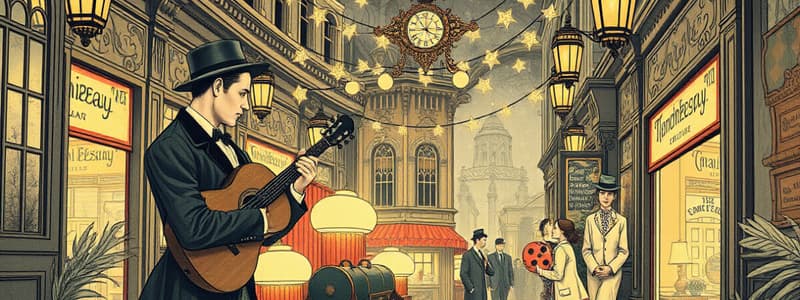Podcast
Questions and Answers
What does the term Tin Pan Alley describe?
What does the term Tin Pan Alley describe?
- The music publishing industry in the first half of the 20th century (correct)
- A genre of jazz music
- A type of recording process
- A popular radio program
Who was Bing Crosby?
Who was Bing Crosby?
A crooner, pop singer, and film star known for 'White Christmas'.
What is the Swing Era?
What is the Swing Era?
The period from 1935-1946 when big band jazz was the most popular music in America.
Who is known as the first star of the swing era?
Who is known as the first star of the swing era?
What does the term race music refer to?
What does the term race music refer to?
What is the significance of Billboard magazine?
What is the significance of Billboard magazine?
What is the electrical process in music recording?
What is the electrical process in music recording?
What format is an album?
What format is an album?
What does a single refer to?
What does a single refer to?
What is Doo-Wop?
What is Doo-Wop?
What is bluegrass music?
What is bluegrass music?
Who popularized black gospel music?
Who popularized black gospel music?
What does melisma refer to in music?
What does melisma refer to in music?
What is the Mississippi Delta known for?
What is the Mississippi Delta known for?
Flashcards are hidden until you start studying
Study Notes
Music Industry Terms
- Tin Pan Alley: Refers to the early 20th-century music publishing industry that focused on popular song production.
- Cover: A new recording of an existing song that aims to reinterpret or overshadow the original.
- Major labels: The largest and most influential record companies in the music industry.
- Independent labels: Small, emerging record companies that gained prominence in the 1940s and 1950s.
Influential Artists
- Bing Crosby: An iconic crooner and pop singer known for his role in "White Christmas."
- Frank Sinatra: A transformative artist known for defining a personal vocal style and a charismatic, macho persona; notable song "The Lady Is a Tramp."
- Benny Goodman: The first prominent star of the Swing Era known for his radio program "Let's Dance" and the hit "Sing, Sing, Sing."
- Pat Boone: Achieved great commercial success with covers of Fats Domino’s and Little Richard’s songs, outselling the originals.
Music Genres
- Race music: Encompasses recordings by black artists, including blues and rhythm & blues (R&B).
- Hillbilly music: Traditional southern music rooted in English folk music, which laid the groundwork for modern country music.
- Country blues: The earliest form of the blues usually performed solo with guitar.
- Classic blues: 1920s blues genre predominantly sung by female artists with small group accompaniment.
Blues Characteristics
- AAB lyric form: Structure consisting of three lines where the second line repeats the first.
- Work songs, shouts, and field hollers: African musical forms that originated on plantations, developed by enslaved people to accompany labor.
- Mississippi Delta: Recognized as the birthplace of blues music.
- Robert Johnson: Notable figure with influential music cut "Cross Road Blues" in 1936.
Jazz and R&B
- Jazz: Characterized by improvisation and swing rhythm, focusing on individual expression.
- Black gospel: Gained popularity in the 1930s, notably through Thomas Dorsey’s influence in rock and roll development.
- Louis Jordan: An early crossover artist notable for his song "Choo Choo Ch' Boogie," which blends jazz with R&B.
Musical Formats
- Album: A 33-1/3 rpm 12" Long Play (LP) format introduced by Columbia Records in 1948.
- Single: The 45 rpm 7" format launched by RCA Victor in 1949.
- Top 40: A radio format that plays the most popular 40 songs repetitively, limiting DJ influence.
Disc Jockeys
- Disc jockey (DJ): A radio persona responsible for playing music while engaging the audience with commentary.
- Alan Freed: Renowned as the most influential DJ, he previously performed as a jazz musician.
- Todd Storz: Inventor of the Top 40 format, significantly changing the radio landscape.
Country Music Developments
- Bristol Sessions: Marked the first significant country music recordings in 1927 by Ralph Peer in Bristol, TN.
- Grand Ole Opry: A radio program launched in 1925 that established Nashville as the country music hub.
- Cowboy songs: Traditional music adapted for film, creating a more commercial pop sound.
Honky-Tonk and Bluegrass
- Honky-tonk: A country music precursor to rock and roll with themes revolving around love and heartbreak.
- Bluegrass: Fast-paced acoustic music known for its improvisational solos and ties to traditional American folk music.
Key Influential Artists in Country and Bluegrass
- The Carter Family: Pioneers of country music, influencing future artists with their folk styles.
- Jimmie Rogers: Recognized as the "father of country music," noted for his yodeling and blues-infused melodies.
- Bessie Smith: Dubbed the "empress of the blues," with significant works like "St. Louis Blues."
Studying That Suits You
Use AI to generate personalized quizzes and flashcards to suit your learning preferences.




